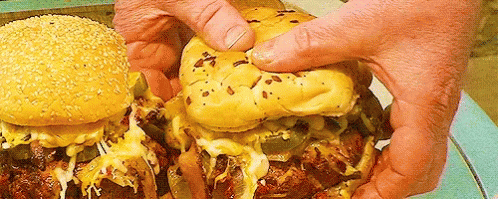It looks like you're using an Ad Blocker.
Please white-list or disable AboveTopSecret.com in your ad-blocking tool.
Thank you.
Some features of ATS will be disabled while you continue to use an ad-blocker.
share:
originally posted by: rickymouse
but that grain fat is not good for people in even moderate amounts,
This is a myth. I used to believe it too, not even that long ago, but I've been watching Dr. Baker and Dr. Chaffees videos on this subject, and apparently it is just a myth.
Yes, grass finished is a little better, but as long as the cows are pastured, healthy, and NOT fed any GMO grain or anything, the fat is just fine - saturated beef fat, in fact, is one of the healthiest foods for humans on God's green earth,
originally posted by: tanstaafl
originally posted by: rickymouse
but that grain fat is not good for people in even moderate amounts,
This is a myth. I used to believe it too, not even that long ago, but I've been watching Dr. Baker and Dr. Chaffees videos on this subject, and apparently it is just a myth.
Yes, grass finished is a little better, but as long as the cows are pastured, healthy, and NOT fed any GMO grain or anything, the fat is just fine - saturated beef fat, in fact, is one of the healthiest foods for humans on God's green earth,
Have you ever seen the comercial feed lots, they feed the cattle almost a hundred percent grains to build up the marbling in the meat. I know farmers who sell their cattle to them. They ask questions and I guess that in four months of feeding the cattle grains stuck in lines the cattle get really big. Now a farmer who gives a little treat of grains to the cow, that is not a problem and even if they finish the cow on a mix of hay and grain it does not so much effect the cow as long as the cows can get exercise. I have been buying a whole cow or half cow for over thirty years from farmers, most let the cows just graze in the fields and finish them for three weeks on oats and barley. That beef was real good....but not as good as the hundred percent grassfed beef we get as far as taste. Only had one fully grain fed cow I bought, never buy that kind of cow again. The yeild in that was about sixty percent of hanging weight, the yield from our grassfed is around seventy eight. And that full grain fed hefford/angus cross was too tender and they could not age it more than three days because it would have fallen apart. The flavor in meat comes out with aging, we get ours aged a minimum of fourteen days. If it goes over three weeks it gets too flavorful though.
Our beef does not have much marbling at all, in fact it is almost too lean, but it has so much more flavor it is worth chewing and cutting it. What does it cost for pound, We pay four dollars and twenty five cents a pound hanging weight this fall, which if I figure it like the last six limosine half heads it will come out to cost about seven bucks a pound for hamburger, roasts, and steaks and above, and for things like short ribs, and super meaty soup bones I figure it will be around three eighty a pound. I figure the marrow bones and sewet for rendering and heart and liver will cost a couple bucks a pound. Because of extra gas costs, our cost per pound has gone up a quarter hanging weight. I don't taste any difference in their beef when it went to certified organic and certified 100% grassfed, but that certification cost us about a hundred bucks a half....they were growing it that way before they got certified so there is no difference. Limosine or Limosine cross tastes better than pure angus anyday, many of the local farmers do the cross, ours are full limosine.
Both the wife and I will never go back to buying commercial beef in the stores anymore, that is flavorless...in fact, we don't even order steak or any big burgers in restaurants anymore, just go out for fish fry and chinese and pizzas, because the beef has no taste compared to ours. We do not buy our half cow for it's health benefits, we buy it because of taste, the added side effect of a better lipid profile is only concerning to us because we get a half a cow and eat lots of beef.
Do you know that Whitefish found in the great lakes actually has as much omega threes as wild salmon....because white fish is a type of salmon I suppose even though it does not taste like salmon. We stock up on whitefish every year too, it jumped up in price and I buy whole ones from Lake Superior, went up to six bucks a pound...that correlates to about seven fifty a pound for the filets when I filet them. The heads and bones don't weigh that much on a whitefish so we save about four bucks a pound. Three years ago I was paying three fifty a pound, I guess those boats suck up the gas.
Find official research and you will find that grain fed beef actually increases cancer risk while one hundred percent grassfed does not increase cancer risk and might actually be a little anticancer depending on the grasses that the cows eat. Our farmer we get ours from...and most of the other farmers we got beef from specially picked the grass mixtures in their fields. When we had our farm when I was young, the hays were specially planted to increase taste in the cows meat...this also effects the flavors of milk from cows that graze and are fed hay. It is not always about nutrition, it is also about flavor and a good flavor means there is a mix of proper nutrients in the animal...this goes for eggs too.
originally posted by: rickymouse
a reply to: tanstaafl
Have you ever seen the comercial feed lots, they feed the cattle almost a hundred percent grains to build up the marbling in the meat.
Yes, but this isn't generally done over the life of the cow, only in the last few weeks/months right before slaughter.
It is a matter of money. It costs a LOT more to feed them grains than it dies to just let them eat grass. Also, it matters WHAT grains are fed to them. I would never buy beef that is finished on GMO garbage grains like soy and corn.
Do some do this? Of course. Just don't buy from them.
The marbling that comes from the grain finishing process actually provides much more flavor than the grass finished ever has.
To each his own, but your claim that grain finished causes cancer or has other health risks is just a claim with nothing of substance to back it up.
Or can you provide some real, actual studies showing this? I'm open minded, and always willing to change my beliefs, but it takes real evidence, and I trust Dr. Shawn Baker, Dr. Anthony Chaffee, and their abilities to analyze the actual science around these claims, and it is the fact that even they changed their minds about this after looking closely at the available research and applying logic and reason to the information that is available.
originally posted by: tanstaafl
originally posted by: rickymouse
a reply to: tanstaafl
Have you ever seen the comercial feed lots, they feed the cattle almost a hundred percent grains to build up the marbling in the meat.
Yes, but this isn't generally done over the life of the cow, only in the last few weeks/months right before slaughter.
It is a matter of money. It costs a LOT more to feed them grains than it dies to just let them eat grass. Also, it matters WHAT grains are fed to them. I would never buy beef that is finished on GMO garbage grains like soy and corn.
Do some do this? Of course. Just don't buy from them.
The marbling that comes from the grain finishing process actually provides much more flavor than the grass finished ever has.
To each his own, but your claim that grain finished causes cancer or has other health risks is just a claim with nothing of substance to back it up.
Or can you provide some real, actual studies showing this? I'm open minded, and always willing to change my beliefs, but it takes real evidence, and I trust Dr. Shawn Baker, Dr. Anthony Chaffee, and their abilities to analyze the actual science around these claims, and it is the fact that even they changed their minds about this after looking closely at the available research and applying logic and reason to the information that is available.
nutritionj.biomedcentral.com...
I'll stick to what we are doing. Our T-bone steaks, Rib steaks, and porterhouse steaks, filet mignon, and flank steaks cost the same as our sirloin steaks, burger, chuck roasts, round steaks, minute steaks, cube steaks, and stew meat...all are less than seven bucks a pound which is based on the weight of the actual meat we get, four twenty five a pound for the hanging weight and fifty five cents a pound hanging weight for processing plus the fifteen bucks butchering cost per half. We weigh the meat we get. Now all the local people who raise their grazed beef and then finish on grains here charge about the same...when I first started buying beef it was a buck a pound hanging weight and thirty five cents a pound plus butchering fee to get it processed....thirty years ago.
There is no comparison of the quality of the taste of beef that a farmer takes good care of and the taste of a commercial cut of beef in the store. I only had one bad steer, it was too marbled, it tasted like corn. A farmer down our road has cows, he feeds them just a little hay and all corn, the manure is full of corn...he gave my brother and I a pound of burger each and it was not very flavorful. Like I said grain fed beef suffers from natural aging, it is why the use the quick wet aging to do beef coming from the commercial suppliers, the stores get their beef around her in big sealed bags, straight from the processing facility and in three days they age it artificially. The reason why natural long term aging does not work well with comercial beef is because the cows fed grains vs grass do not have as much elastin binding protein, only bacteria can make that and that protein is found on grasses and in the rumans of cows that eat grass and hay at high percentages. Oats and corn diets support another kind of microbe which dominates the rumans of grain finished cows, so that change in the microbes in their digestive system eliminates the amount of elastin fiber, what they have is just in the hearts, blood vessels, in the coating of the nerves, and in the bones if they were grazed for many moons....so the beef is tender.
No animal or plant can produce elastin binding protein, just certain microbes like some e-choli and some stapholocaucus...humans need this in moderation especially for nerve coatings, tough guts and stomachs, heart muscle, blood vessels, and tough skin. Too much can cause problems with the heart though, so we cannot continually eat animals high in it, with that venison and grass fed beef, we also need to have some fish and chicken which is low in it...except for the heart and some select tough parts of a chicken. Lack of this protein in the diet causes some critical diseases as we see in the USA today. I consider this an important chemistry...it binds our joints and bones together stronger too.
Look at all the operations on knees and hips these days. Look at the bones of people getting weaker, this practice of change of diet for the animals is causing more tender meat and also more tender people who eat the meat. It is rare that a person can have these particular microbes living symbiotically in their gut, but those who do are stronger and do not need to consume the elastin binding protein. But their poop is problematic to others, hence they require hand washing in grocery stores and restaurants by employees after using the john
There are multiple factors involved in classifying a food as healthy or not, being aged for two weeks or more our steaks are just as tender as store meat, but the natural aging is caused by enzymes present in the meat, not by microbes. Those enzymes only break apart the elastin binding proteins, they become more bioavailable that way, but in grain fed beef, they are not present in adequate amounts because the microbes forming them are not present in the ruman. Also the collagen in organic beef is better, it has a glycine bond that is more pure, conventional commercial grain feed most often has high levels of a residue forming the glycine bond from glyphosate residue. This makes the glycine bond weaker, so again the meat is more tender. the antidote for glyphosate poising is glycine added to the diet. Again, preharvest treating of grains we eat too contains glyphosate residue which weakens our muscles and joints. There is about ten fold the amount of glyphosate used on animal feed than allowed in human feed. Everyone wants that nice tender steak...which makes us much more susceptable to joint deterioration and muscle and tendon ruptures. Organic regular beef is not allowed to be fed glyphosate treated grains.
CLA, vitamin A, and vitamin E is higher in grass fed beef, all three of those have anti-cancer properties. People do not understand that this little amount extra in their burger replaces the need for a supplement of those, I do not take either of those supplements, I get plenty in my diet. The vitamin A in beef is a retinoid, which is good for the eyes. I compared the vitamin and mineral data on both hundred percent grass fed beef and store bought beef years ago on nutritiondata site, before the government who funded their project told them they had to stop publishing the organic stuff and combine the results with all the rest of the foods in that catagory. This made the commercial beef look better while they got rid of the organic data. I was actually shocked by a lot of the differences in real food that was grown organically and naturally from what is found in commercial products.
There are many sites stating that the lipid ratio of omega 6 to three in Grass fed beef is way better than in commercial beef. But remember this, beef found in States like Texas and some big grazing states is included in the not grass fed statistics too, in Texas, they have a lot of good quality beef direct from farm or processing facility which was just taken off the ranges that they sell to their local populations. It is good
originally posted by: rickymouse
a reply to: tanstaafl
nutritionj.biomedcentral.com...
Not a single surprise there, and nothing of note. Just another summary of multiple epidemiological 'studies' that don't show anything meaningful, just a bunch of hooie regurgitating the same old same old lies that saturated fat causes heart disease, that cholesterol is your enemy, etc ad nauseum.
Of course, such blanket pronouncements as the rest of your comments are meaningless when you consider the vast number of potential differences from one farmer to the next.
Meaning: meat from a cow that was fed large amounts of GMO soy, corn, etc is much much lower quality than meat from a cow that ate grass all its life until the last 3-6 months, then ate locally grown non GMO wheat and barley. Meat from a grass fed and finished cow is marginally better than the non GMO grain finished, but only marginally - meaning, not statistically significant, and certainly not enough to justify paying twice as much.
I'll stick to what we are doing.
I'm not trying to change your mind...
Our T-bone steaks, Rib steaks, and porterhouse steaks, filet mignon, and flank steaks cost the same as our sirloin steaks, burger, chuck roasts, round steaks, minute steaks, cube steaks, and stew meat...all are less than seven bucks a pound
I've bought many a whole cow, I understand how that works... but you also get a whole lot of cuts that you don't want.
Everyone wants that nice tender steak...which makes us much more susceptable to joint deterioration and muscle and tendon ruptures.
Ummm... it isn't meat that causes joint deterioration, it is carbs, especially sugar.
Last time I was LA I went to Carneys. You want some chili with that burger? Lol
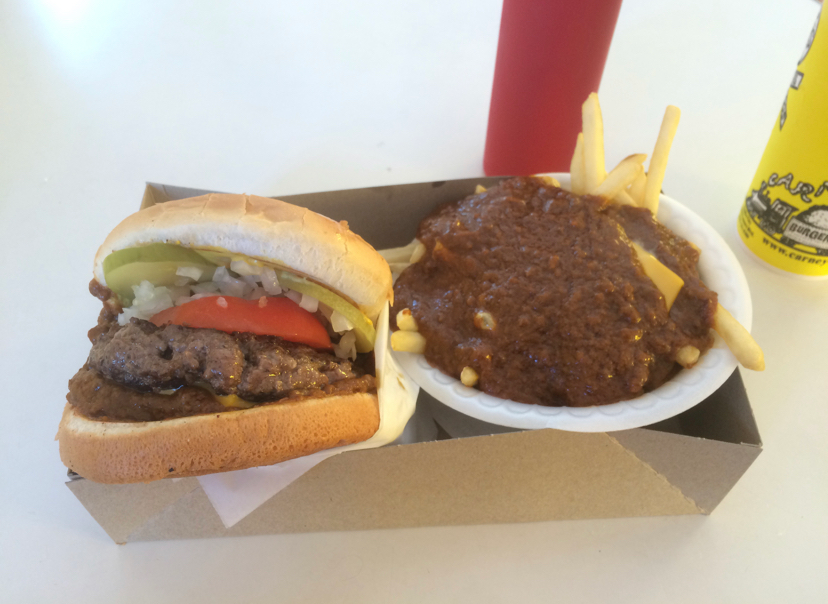
The homemade deal
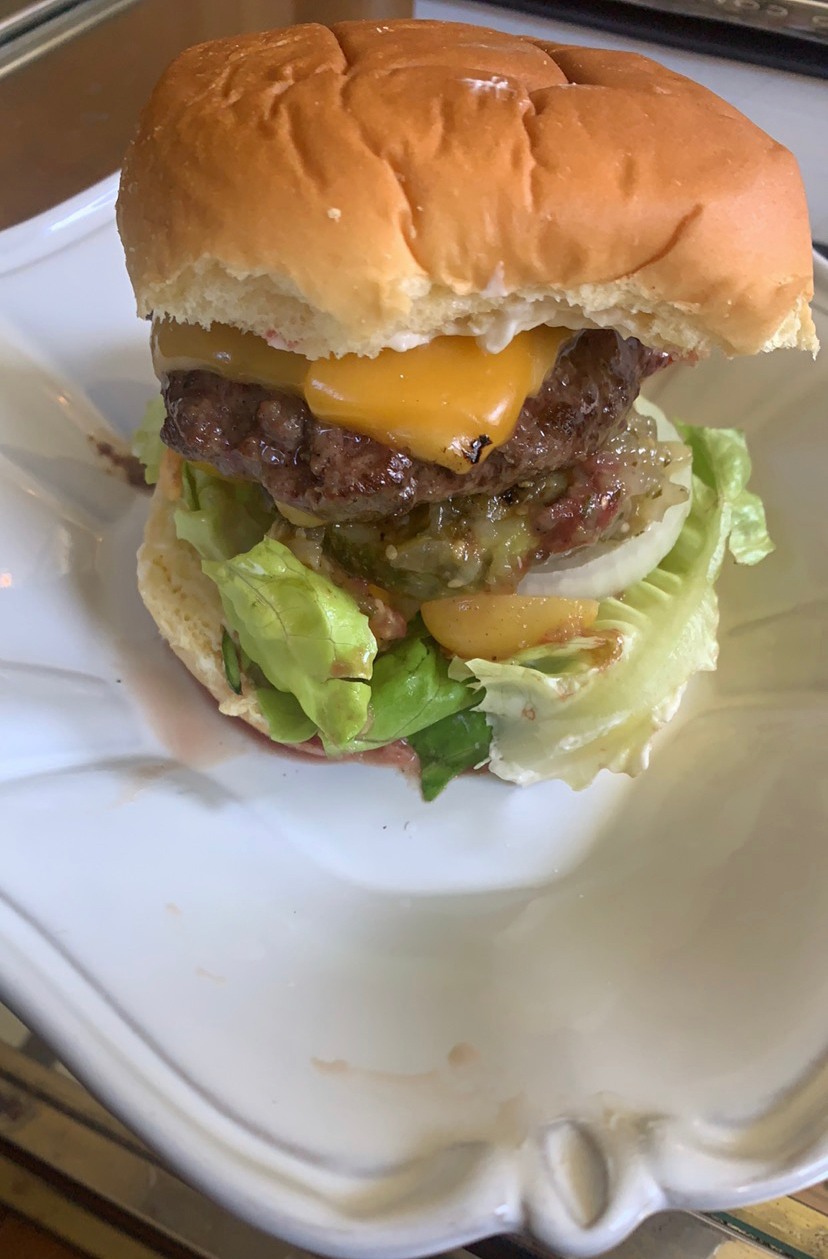
Upper east side JG Melon burger. Love it. But only that location.
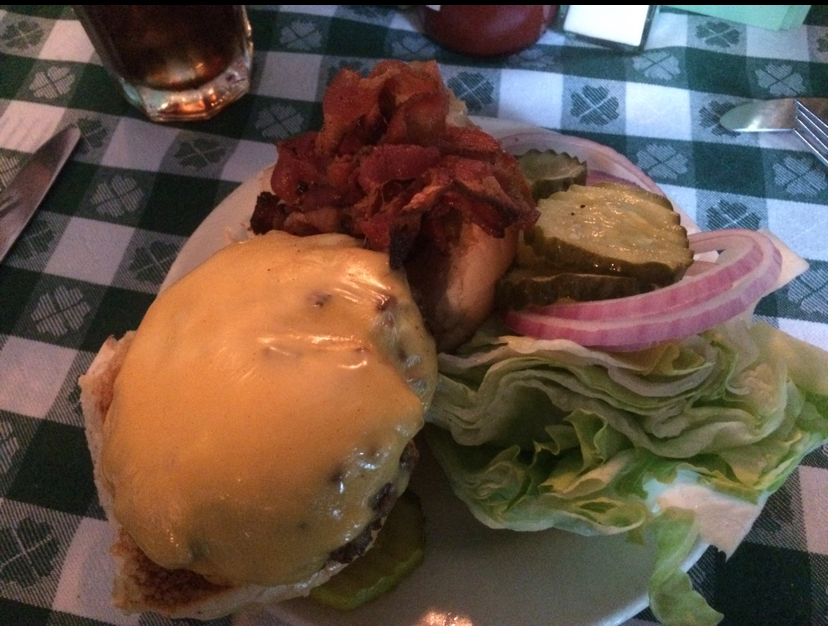
I think the hot dog feels left out

Heresy on the hamburger thread——
Back when I used to make sausages for the restaurant
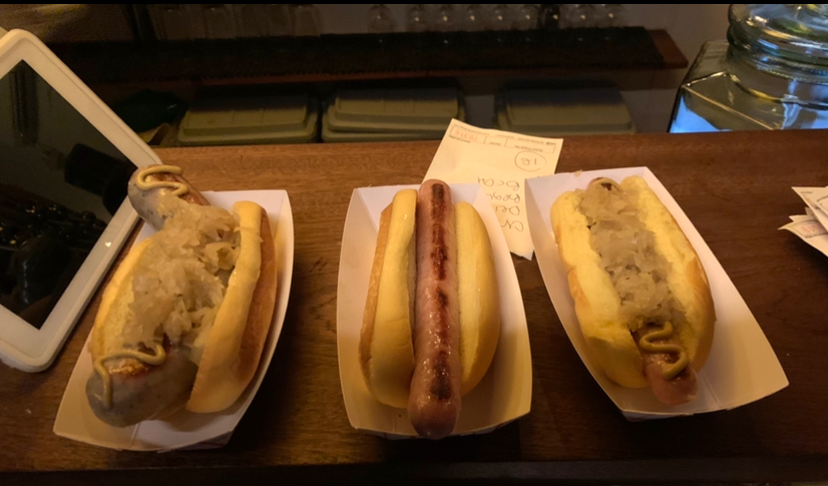

The homemade deal

Upper east side JG Melon burger. Love it. But only that location.

I think the hot dog feels left out

Heresy on the hamburger thread——
Back when I used to make sausages for the restaurant

a reply to: tanstaafl
Yeah, I know what you mean about getting cuts you don't want. We give away over half of the rib steaks, T bones, and porterhouses and the sirloin tip and rolled rump roasts. We would rather just buy the soup bones, Hamburger, sirloin steaks, liver, Short ribs, Chuck roasts, and soup bones and make bone broth from the marrow bones because those are what we like the best. But the kids like those steaks and one daughter likes the Rolled rump so she gets those, the other daughter likes the Chuck roasts...so we give her the sirloin....we aren't giving away the chuck roasts.
How much a pound is a hanging half going for by you now? We are paying about a quarter a pound more for ours than other farmers are charging for their regular halfs around here now. That is because their cost went up about a hundred bucks a half to cover the certifications and inspection fees. which comes out to about a about twenty five cents a pound on a four hundred h pound side of beef..
This may be the last year we buy a half from them because they are talking about stopping because they are getting too old to do all the work and their health is deteriorating. He had to get a shoulder and a back surgery in the last five years and she had problems with some membrane rupturing at the bottom of her guts, surgeries are making it hard to maintain the farm. Also they had to buy a new baler, their baler caught fire from a bearing that overheated and ignited the hay. They don't employ anyone, just one guy who comes to help out occasionally who is another farmer that they know and one helps the other when needed.
We never buy T-bones, rib steaks, or porter house steaks so I guess it would be cheaper to buy from the store if they actually had meat with flavor in stores which they do not have around here. At Rainbow Packing they do have regular beef they sell, because they raise some of their own and buy some from the kids at the fair auctions, but ours is cheaper per pound even though half the steaks go to my brother, nephew, daughter and family, and other daughter and family, and granddaughters family for Christmas.
Remember, we have bought at a half or whole cow or steer every year for thirty years, four different farmers we have known over the years. The days of the buck a pound hanging weight have been gone for twenty five years and have been watching the price increase every couple of years by a quarter to fifty cents a pound hanging weight. I used to buy a whole steer for around the first ten years and give the employees a nice bonus every year.
The wife and I agree, we will never start buying commercial beef again. There is no flavor. The taste some places say about grass fed beef being grassy does not apply to our suppliers cows, but grass fed beef in the supermarket has a weird taste. We buy things to compare and sometimes will try a pound of crappy ground chuck from the store just to remind us of how good we got it.
Grew up on a farm and talk to a lot of farmers yet, quite a few of them don't give the same diet to the cows they sell to market than they feed to the ones they give to their friends, relatives, and eat themselves. They feed the ones they sell to stockyards foods that make them grow faster, and those are usually angus while the ones they keep are angus crosses because the flavor is better. They also keep their own food animals in better fields so their beef tastes better....
A lot of the knowledge I have comes from talking to farmers over the years about stuff, heck, I feel at home talking to them.
Yeah, I know what you mean about getting cuts you don't want. We give away over half of the rib steaks, T bones, and porterhouses and the sirloin tip and rolled rump roasts. We would rather just buy the soup bones, Hamburger, sirloin steaks, liver, Short ribs, Chuck roasts, and soup bones and make bone broth from the marrow bones because those are what we like the best. But the kids like those steaks and one daughter likes the Rolled rump so she gets those, the other daughter likes the Chuck roasts...so we give her the sirloin....we aren't giving away the chuck roasts.
How much a pound is a hanging half going for by you now? We are paying about a quarter a pound more for ours than other farmers are charging for their regular halfs around here now. That is because their cost went up about a hundred bucks a half to cover the certifications and inspection fees. which comes out to about a about twenty five cents a pound on a four hundred h pound side of beef..
This may be the last year we buy a half from them because they are talking about stopping because they are getting too old to do all the work and their health is deteriorating. He had to get a shoulder and a back surgery in the last five years and she had problems with some membrane rupturing at the bottom of her guts, surgeries are making it hard to maintain the farm. Also they had to buy a new baler, their baler caught fire from a bearing that overheated and ignited the hay. They don't employ anyone, just one guy who comes to help out occasionally who is another farmer that they know and one helps the other when needed.
We never buy T-bones, rib steaks, or porter house steaks so I guess it would be cheaper to buy from the store if they actually had meat with flavor in stores which they do not have around here. At Rainbow Packing they do have regular beef they sell, because they raise some of their own and buy some from the kids at the fair auctions, but ours is cheaper per pound even though half the steaks go to my brother, nephew, daughter and family, and other daughter and family, and granddaughters family for Christmas.
Remember, we have bought at a half or whole cow or steer every year for thirty years, four different farmers we have known over the years. The days of the buck a pound hanging weight have been gone for twenty five years and have been watching the price increase every couple of years by a quarter to fifty cents a pound hanging weight. I used to buy a whole steer for around the first ten years and give the employees a nice bonus every year.
The wife and I agree, we will never start buying commercial beef again. There is no flavor. The taste some places say about grass fed beef being grassy does not apply to our suppliers cows, but grass fed beef in the supermarket has a weird taste. We buy things to compare and sometimes will try a pound of crappy ground chuck from the store just to remind us of how good we got it.
Grew up on a farm and talk to a lot of farmers yet, quite a few of them don't give the same diet to the cows they sell to market than they feed to the ones they give to their friends, relatives, and eat themselves. They feed the ones they sell to stockyards foods that make them grow faster, and those are usually angus while the ones they keep are angus crosses because the flavor is better. They also keep their own food animals in better fields so their beef tastes better....
A lot of the knowledge I have comes from talking to farmers over the years about stuff, heck, I feel at home talking to them.
new topics
-
Early voting results
2024 Elections: 1 hours ago -
Project Redsun: NASA's Secret Manned Missions to Mars The Why Files
Space Exploration: 7 hours ago -
President BIDEN Approved Omitting from the Transcript That He Called Trump Supporters GARBAGE.
2024 Elections: 8 hours ago -
Strong and Intelligent women
2024 Elections: 10 hours ago -
Candidate Harris Supporter MARK CUBAN Says Trump Has No Smart-Intelligent Women in His Orbit.
2024 Elections: 11 hours ago
top topics
-
What Happens if They Manage to Take Him Out BEFORE the Election?
2024 Elections: 15 hours ago, 12 flags -
Candidate Harris Supporter MARK CUBAN Says Trump Has No Smart-Intelligent Women in His Orbit.
2024 Elections: 11 hours ago, 8 flags -
Joe Rogan Experience #2221 - JD Vance
2024 Elections: 15 hours ago, 7 flags -
Colorado voting system passwords didn't start getting changed until after p/w leak became public
2024 Elections: 13 hours ago, 7 flags -
Double Homicide.
Short Stories: 14 hours ago, 6 flags -
Strong and Intelligent women
2024 Elections: 10 hours ago, 4 flags -
From Tribes to Superpowers: The Evolution of Human Societies Toward Global Dominance
New World Order: 16 hours ago, 4 flags -
President BIDEN Approved Omitting from the Transcript That He Called Trump Supporters GARBAGE.
2024 Elections: 8 hours ago, 2 flags -
Project Redsun: NASA's Secret Manned Missions to Mars The Why Files
Space Exploration: 7 hours ago, 2 flags -
Early voting results
2024 Elections: 1 hours ago, 2 flags
active topics
-
Early voting results
2024 Elections • 2 • : ElitePlebeian2 -
The Reactionary Conspiracy 13. The plot’s theology.
General Conspiracies • 279 • : MarxistDebunker2 -
Candidate Harris Supporter MARK CUBAN Says Trump Has No Smart-Intelligent Women in His Orbit.
2024 Elections • 54 • : network dude -
A New Dating Site For The Unvaxed
Diseases and Pandemics • 52 • : MetalThunder -
Remember when Iraq invaded Kuwait
History • 13 • : fringeofthefringe -
Tommy Robinson jailed again.
Mainstream News • 83 • : andy06shake -
That "Welsh" Guy who Killed the Girls in Southport Now Charged with Terrorism Offences
Social Issues and Civil Unrest • 19 • : bastion -
Project Redsun: NASA's Secret Manned Missions to Mars The Why Files
Space Exploration • 3 • : CosmicFocus -
President BIDEN Approved Omitting from the Transcript That He Called Trump Supporters GARBAGE.
2024 Elections • 11 • : MetalThunder -
Nephilim looked like clowns
Conspiracies in Religions • 36 • : mytquin


